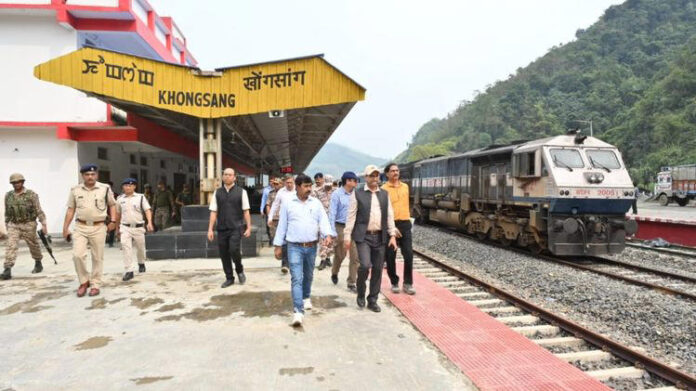The Jiribam-Khongsang rail line in Manipur, a key infrastructure project aimed at improving connectivity in the northeastern region, recently received a significant boost as the General Manager (GM) of the Northeast Frontier Railway (NFR) undertook an inspection tour of the site. This visit highlighted the steady progress of the project, which has been one of the most anticipated railway projects in the state. The rail line is expected to enhance transportation, spur economic growth, and improve access to essential services for the people of Manipur and the surrounding regions.
Overview of the Jiribam-Khongsang Rail Line
The Jiribam-Khongsang rail line, an ambitious undertaking by the Indian Railways, is being constructed to connect the town of Jiribam in Manipur to Khongsang in the state’s eastern region. This project, once completed, will be a vital part of the larger goal to integrate the northeastern states into India’s broader national transportation network.
The rail line will provide a much-needed alternative to road transportation, significantly reducing travel time and costs. It will also ensure better accessibility to Manipur, which, due to its geographical location and rugged terrain, has been somewhat isolated from the rest of the country in terms of efficient transportation infrastructure. The rail line is expected to boost trade, tourism, and local economies by providing easier access to goods, services, and people.
Inspection Tour by NFR GM
The NFR GM’s visit to the construction site was an important step in reviewing the progress of this critical project. The inspection included a detailed assessment of the work being carried out along the Jiribam-Khongsang stretch, including the laying of tracks, construction of bridges, and the development of stations. The GM was accompanied by senior railway officials and project managers, who briefed him on the status of various components of the project.
The Jiribam-Khongsang rail line has faced several challenges during its construction due to the region’s difficult terrain and weather conditions. These obstacles have led to delays and necessitated the use of advanced engineering techniques to ensure the project’s timely completion. The NFR GM’s visit was an opportunity to review the hurdles on the ground and assess the strategies being employed to overcome them.
During his inspection, the GM acknowledged the significant progress made by the construction teams and emphasized the importance of maintaining momentum to meet the project’s deadlines. He encouraged the workers and engineers to continue working diligently while adhering to the highest standards of safety and quality.
Key Developments in the Project
The Jiribam-Khongsang rail line project is progressing on multiple fronts. One of the major challenges faced in the region has been the construction of tunnels and bridges due to the hilly terrain. The railway project involves building several bridges over rivers and ravines, along with the construction of tunnels through the hills to provide a stable route for the train tracks.
Another critical aspect of the project is the development of stations and related infrastructure. The NFR is working to ensure that the stations along the rail line are equipped with modern amenities and safety features to meet the growing demand for transportation in the region.
Furthermore, work on the electrification of the line is also progressing, with the goal of making the rail line environmentally sustainable and energy-efficient. Once completed, the line will be capable of handling both passenger and freight trains, helping boost trade and movement of goods between Manipur and other parts of India.
Economic and Social Impact
The completion of the Jiribam-Khongsang rail line is expected to have a transformative impact on Manipur’s economy. The state has long been dependent on road transport for the movement of goods, which has been costly and time-consuming. The rail line will not only improve connectivity with the rest of the country but also facilitate the movement of goods and services to and from the region with greater ease.
The rail line will also have a significant social impact, particularly in terms of enhancing access to education, healthcare, and employment opportunities. It will connect remote areas of the state to larger urban centers, reducing isolation and helping integrate the population into the national mainstream.
Additionally, the improved transport network is expected to boost tourism in Manipur, a state known for its rich cultural heritage, scenic beauty, and unique biodiversity. Easier access to the state’s historical sites and natural landscapes will likely attract more tourists, contributing to local businesses and creating employment opportunities for the residents.
Challenges and Future Prospects
While the progress of the Jiribam-Khongsang rail line has been encouraging, the project has not been without its challenges. The region’s complex topography, heavy rainfall, and frequent landslides have made construction particularly difficult. Additionally, security concerns in some areas have also delayed work at times.
However, the central government and the NFR have remained committed to completing the project, recognizing its importance for the development of the region. The project is also part of the broader Act East Policy, which aims to strengthen connectivity between India and its neighboring countries in the Southeast Asia region.
Once completed, the Jiribam-Khongsang rail line will not only be a symbol of progress for Manipur but also contribute to the broader goal of creating a more integrated and accessible northeastern India. The development of modern infrastructure will serve as a catalyst for further investments in the region, unlocking new economic opportunities and improving the overall quality of life for the people.
The inspection of the Jiribam-Khongsang rail line by the NFR General Manager serves as a reminder of the significant strides being made in connecting Manipur to the rest of India. The successful completion of this project will not only improve transportation in the region but also pave the way for greater economic integration and development. With ongoing efforts to overcome challenges and maintain the pace of construction, the dream of a well-connected Manipur is gradually becoming a reality.




